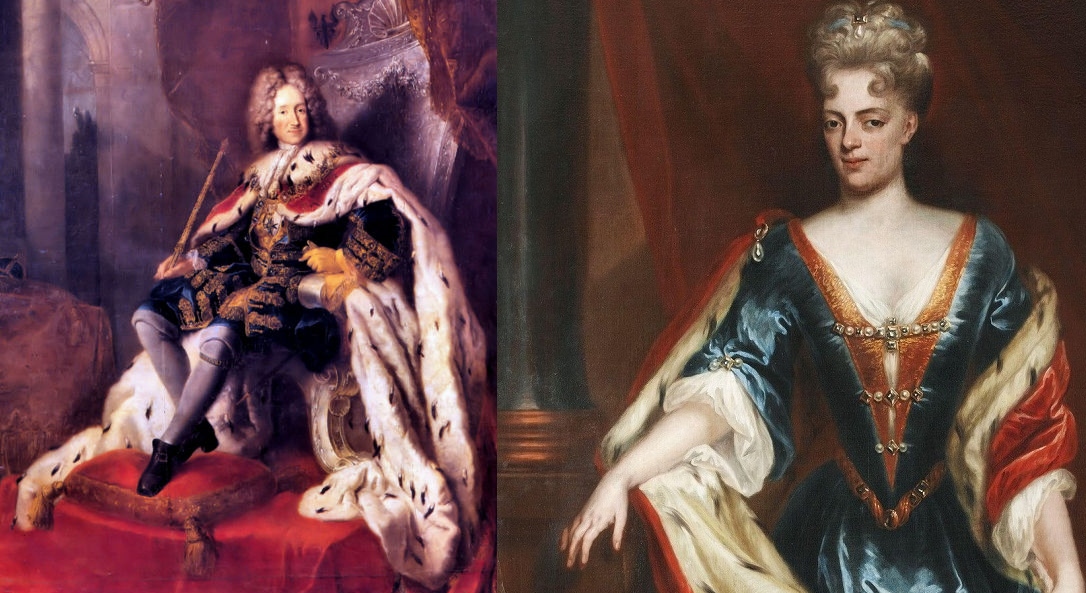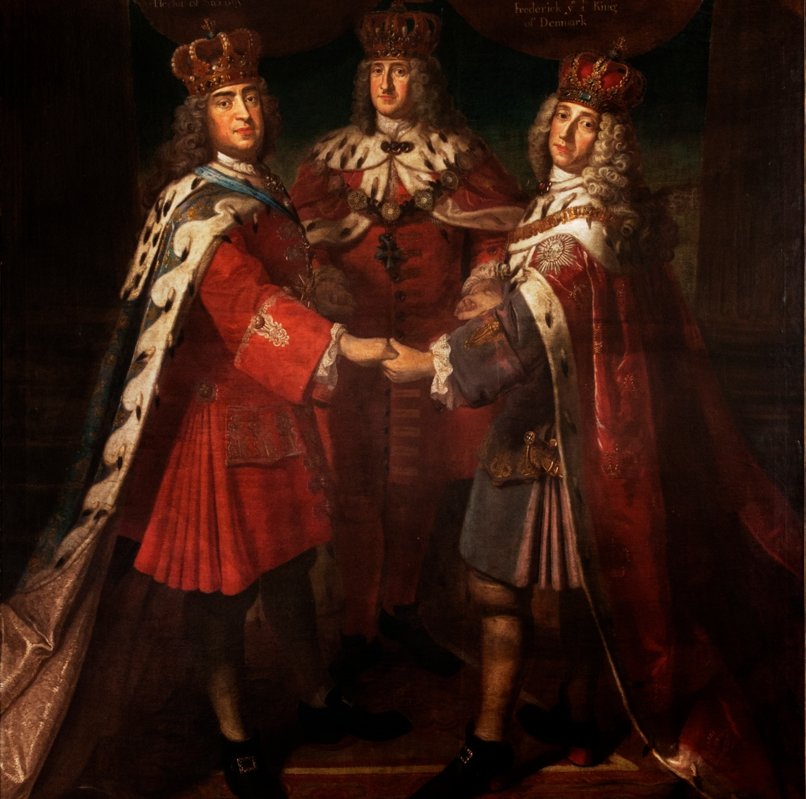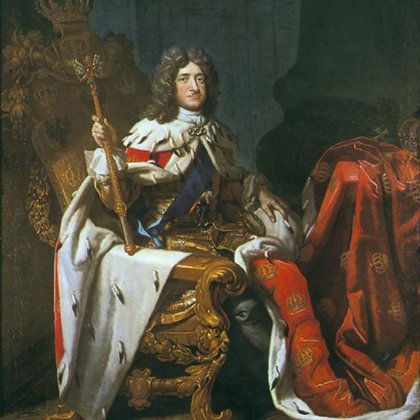FRIDRICH I ,ELECTOR OF BRANDENBURG (1657-1713) WAS THE FIRST KING OF PRUSSIA (GERMANY).ALTHOUGH HE WAS THE NEWEST AND THE LEAST IMPORTENT OF ALL EUROPEAN KINGS.
 Frederick was married three times: first to Elizabeth Henrietta of Hesse-Kassel, with whom he had one child,Louise Dorothea, born 1680, who died without issue at age 25.Then to Sophia Charlotte of Hanover, with whom he had Frederick August (1685–1686) Frederick William I, born in 1688, who succeeded him.In 1708, he married Sophia Louise of Mecklenburg-Schwerin, who survived him but had no children by him.He also had an official mistress, Catharina von Wartenberg, between 1696 and 1711.
Frederick was married three times: first to Elizabeth Henrietta of Hesse-Kassel, with whom he had one child,Louise Dorothea, born 1680, who died without issue at age 25.Then to Sophia Charlotte of Hanover, with whom he had Frederick August (1685–1686) Frederick William I, born in 1688, who succeeded him.In 1708, he married Sophia Louise of Mecklenburg-Schwerin, who survived him but had no children by him.He also had an official mistress, Catharina von Wartenberg, between 1696 and 1711.
The Hohenzollern state was then known as Brandenburg-Prussia, as the family had possessions including Brandenburg within the Holy Roman Empire and Ducal Prussia outside of the Empire. Although he was the Margrave and Elector of Brandenburg and the Duke of Prussia, Frederick desired the more prestigious title of king. However, according to Germanic law at that time, with the exception of the Kingdom of Bohemia, no kingdoms could exist within the Holy Roman Empire.Initially Prussia was a fief of the Kingdom of Poland. In 1525 during the Protestant Reformation, Prince Albert of Brandenburg, a scion of the House of Hohenzollern and the Grand Master of the Teutonic Knights, secularized the order’s Prussian held territory, becoming Albert, Duke of Prussia. The new Duchy, which had its capital in Königsberg was established as fief of the Crown of Poland. In time it was inherited by the Hohenzollern prince-electors of Brandenburg of the main Branch of the House of Hohenzollern. Because of this personal union with the Electorate of Brandenburg the Duchy is often referred to as Brandenburg-Prussia. In 1657 the Treaty of Wehlau, and then in 1660 the Treaty of Oliva granted Friedrich-Wilhelm, the “Great Elector” of Brandenburg, full sovereignty over the territory. In 1701 The Duchy of Prussia was elevated to the Kingdom of Prussia, with Elector Friedrich III assuming the style of King Friedrich I in Prussia.Brandenburg-Prussia made it an attractive ally. Its reputation also allowed Frederick to convert the state into a monarchy. By the reign of Frederick I, the title 'Elector' had declined in status and importance, making the title ‘King of Prussia’ especially attractive.The Holy Roman Emperor, Leopold, called on Frederick for help during the War of Spanish Succession. In return providing Leopold with 8,000 soldiers, Frederick was rewarded with permission to himself King of Prussia.During his reign, Frederick embarked on an impressive building campaign. His lavish approach to kingship included castle building and collecting of works of art.However, Frederick did not only focus on his own status. In the 1690s he created schools, universities and cultural centres that reflected Brandenburg-Prussia's rise as a cultural, intellectual and educated state in Europe. In 1694, a university had been established at Halle, which further boosted the state’s intellectual credentials.In 1696, Frederick established an Academy of Art and an Academy of Science a year later. In his development of culture, Frederick was greatly influenced by wife, Sophie Charlotte. She wanted to promote the state’s cultural and intellectual output so that it wouldn’t be known only as a military state.Frederick I pushed forward with his father's attempts to modernise the infrastructure of Brandenburg by building more canals and roads and cultivating waste land to expand Brandenburg’s agricultural base.Frederick’s foreign policy was largely focused on a war with Louis XIV of France. Brandenburg’s army fought with WIlliam III of the United Provinces and gained a reputation as being well-trained, fearless soldiers. His growing reputation made William a desirable ally for other European powers, while the subsidies received for the troops made Brandenburg a wealthy state.By the time of Frederick’s death in 1713, Brandenburg-Prussia was considered Europe's greatest force. France had been dragged down by the reign of Louis XIV; Spain had lost much of her power; and no German state was able to match Brandenburg-Prussia.Brandenburg-Prussia played a role in the Great Northern War, which was fought between Sweden’s Charles XII and a coalition led by Peter the Great. Prussia entered the Great Northern War in March 1715. Prior to this much of the Prussian army had been involved in various theatres of the War of Spanish Succession.The capture of Stettin in September 1713 had created an uneasy relationship between Prussia and Sweden. There then followed an uneasy period in Prusso-Swedish relations before war broke out, following the conclusion of the War of Spanish Succession.Prussia's primary objective during the war was to clear Swedish forces from their remaining strongholds in Germany. The Prussians were part of the Allied force which besieged Stralsund between July 1715 and it's surrender in December 1715 and also of Wismar between March and April 1716. During the siege of Stralsund an Allied force, including Prussian troops, invaded the island of Rugen. This was vital to the Swedish war effort as it was the only supply route to besieged Stralsund. This invasion led to the Battle of Stresow in which the Swedes tried unsuccessfully to halt the Allied occupation of Rugen.Frederick married three times during his lifetime. His first wife was Elizabeth Henrietta of Hesse-Kassel, with whom he had one child. The marriage - a love match - was tragically ended after only four years when Elizabeth died of smallpox. Frederick then married Sophia Charlotte of Hanover in 1704, with whom he had two children, only of one of which survived beyond infancy. In 1708, he married Sophia Louise of Mecklenburg who survived him.
 Coronation of Frederick I in Konigsberg.The Coronation Of Frederick As The First King Of Prussia At Konigsberg 18 January 1701 Wood Engraving 19Th Century After A Contemporary Line Engraving Frederick I (1657-1713)
Coronation of Frederick I in Konigsberg.The Coronation Of Frederick As The First King Of Prussia At Konigsberg 18 January 1701 Wood Engraving 19Th Century After A Contemporary Line Engraving Frederick I (1657-1713)
Friedrich I , King in Prussia (1701-1713, was born 11 July 1657, the third son of Elector Friedrich Wilhelm of Brandenburg (1620-1688), a staunch Calvinist, and Luise Henriette of Orange-Nassau (1627-1667). Friedrich became Friedrich III, Elector of Brandenburg and Duke of Prussia in 1688 on his father’s death, and convinced the Holy Roman Emperor that Prussia could be ruled as a kingdom in 1701.In 1688 he took the side of the Mennonites in the matter of admitting the severely persecuted Swiss Mennonites.Friedrich offered these exiles refuge in his East Prussian realm, especially in the Lithuanian marshes near Tilsit, with a promise of complete freedom from military service and toleration of their principles. He co-operated fully with the Dutch government, which was also deeply interested in these victims of persecution.On 3 May 1710, Friedrich instructed his ambassador in Bern to work for greater toleration of the Mennonites. If this should not be agreeable to the canton, he was determined to "establish them in his realm." He also communicated with the Mennonite churches in The Hague, Amsterdam, and Hamburg-Altona, which were also in active sympathy with the oppressed Swiss.On 26 September 1710, the Swiss government granted the following concessions: The Mennonites were to be permitted to withdraw without hindrance and to dispose of their property upon payment of a 10 per cent emigration fee and with loss of citizenship (the provision also contained a threat of the execution by sword of any who returned). Bern would expedite them to its border at its own expense and feed and lodge the poor as far as Frankfurt. A delegation to the king was not feasible. Only after all the Mennonites had left the country would they be permitted to deal with the king.With the aid of the Mennonites of Amsterdam, Hamburg, and Danzig, a number of the exiles were settled in Lithuania. The king naturally expected a larger number of settlers than actually came, for he had personally secured for all the refugees the necessary passes through the intervening countries. However, most of the exiles went to Holland, and a few families went to Pennsylvania.The Mennonites who settled in Lithuania in 1711, after three delegates had previously looked over the land and found it very fertile, were received there by General von Dönhof and by the Königsberg legal councilor von Reuter in the name of the king. These men were commissioned to promote the settlement in every way possible.From Polish territory, especially around Elbing and Culm, the king drew a number of Mennonite families to Lithuania with the guarantee of complete military freedom. However, he died before the negotiations were completed on 25 February 1713, and was succeeded by his son Friedrich Wilhelm I.Brandenburg’s population expanded significantly during Frederick william’s reign. This was largely due to his policy of allowing refugees to populate the state. As a result, by the time of Frederick, Brandenburg-Prussia was seen as the champion of Protestantism.Frederick William’s policies certainly benefited Frederick I, who enjoyed twice as much royal income and a highly effective civil service which was created during Frederick William’s reign. What’s more, the army increased by 40 per cent, from 50,000 to 30,000. Royal income for Frederick doubled and the civil service created during his reign worked very efficiently by the time of Frederick I. He had also increased the army in size to 50,000 from 30,000 - a 40 per cent increase.Frederick I’s power was extended even further when, in 1702, a Supreme Court of Appeal was created in Berlin. This meant there was no longer any right of appeal to the Holy Roman Empire, giving Frederick more power to make laws.Frederick was a great sponsor of the arts and patronized these lavishly, sometimes spending more than the state could afford. However, this enriched Prussia's physical appearance and set the scene for his successor, who turned Prussia into a major European power.His son, Frederick William I, reformed the civil service and created a standing army. Frederick I had strengthened the army but it was his son who laid the foundation of Prussia's future military might. By negotiating for the title of king in Prussia, Frederick I started the process by which Prussia became the leading German state, eventually achieving the re-unification of Germany under Otto von Bismarck.He is considered to have been an able ruler, who helped to lay the foundation for Prussia's future success. Some may speculate that the Prussian desire to unify and to expand German territory began with Prussia's initial victory against Sweden in 1721 when it gained Pomerania after a war that had started in 1700, during Frederick’s reign although Prussia's involvement came later.
 Meeting of three kings in Potsdam and Charlottenburg, Frederick I. in Prussia -August II. (the Strong), King of Poland and Elector of Saxony - Frederick in 1709.The city palace in Potsdam, Brandenburg was a royal residence of the Prussian monarchs.
Meeting of three kings in Potsdam and Charlottenburg, Frederick I. in Prussia -August II. (the Strong), King of Poland and Elector of Saxony - Frederick in 1709.The city palace in Potsdam, Brandenburg was a royal residence of the Prussian monarchs.

